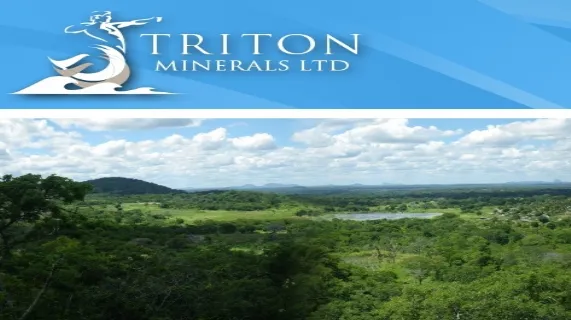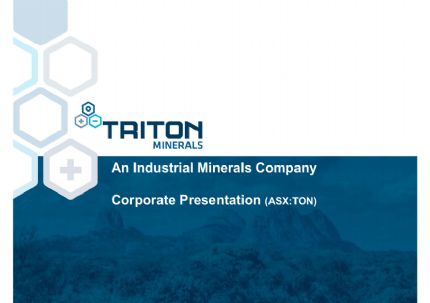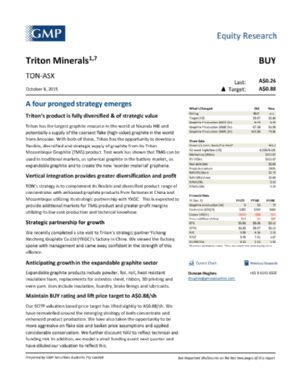
Nicanda Hill Resource Upgraded
Perth, Oct 30, 2015 AEST (ABN Newswire) - Triton Minerals Limited ( ASX:TON) (Triton or Company) is pleased to announce an update to the maiden October 2014 Mineral Resource estimate for the Nicanda Hill graphite deposit at the Balama North project in Mozambique.
ASX:TON) (Triton or Company) is pleased to announce an update to the maiden October 2014 Mineral Resource estimate for the Nicanda Hill graphite deposit at the Balama North project in Mozambique.
The total Mineral Resource estimate comprises 1.44 Billion Tonnes (Bt) at an average grade of 11.1% Total Graphitic Carbon (TGC) and 0.29% Vanadium Pentoxide (V2O5) classified as either Measured Mineral Resources, Inferred Mineral Resources or Indicated Mineral Resources in accordance with the guidelines of the Australasian Code for the Reporting of Exploration Results, Mineral Resources and Ore Reserves (JORC Code, 2012 Edition).
Triton's Managing Director & CEO Brad Boyle said:
"The key objective of the 2015 drill program to define a JORC-compliant measured resource has been achieved. This is a significant outcome for the Company as the Measured Resource will form the basis of the initial ten years of the projected mine life at Nicanda Hill (100) and will create the foundation for defining proven and probable graphite ore reserves at Nicanda Hill.
The area, in which the initial measured resource of 33 million tonnes (Mt) at 12.3%TGC has been defined, represents a small fraction of the entire resource area. Triton is confident that the measured resource can be increased almost five-fold. However, increasing the measured component of the resource is not an immediate priority as the initial 33Mt is more than adequate for the projected first ten year's life of mine.
Triton is also very pleased to note an overall increase in the average grade for both the graphite and vanadium from the original 2014 resource estimate and confirming the high quality nature of the deposit. The resource has been further and independently validated thus demonstrating the accuracy and robustness of the original 2014 mineral resource estimate"
The resource estimate was carried out by independent resource consultants Jorvik Resources Pty Ltd, of Perth, Western Australia (Jorvik).
The updated mineral resource estimate reaffirms the Nicanda Hill deposit as the largest graphite and vanadium deposit in the world. The size of measured classified mineral resource is considered by Triton to be globally significant in both size and the average graphite grade, whilst continuing to reiterate the original fiscal strengths and reasons for developing this world class graphite deposit.
INTRODUCTION
Since the initial mineral resource estimate for Nicanda Hill was released in October 2014, Triton has completed as a part of the Definitive Feasibility Study (DFS) work program, an additional 5,516m of drilling in 51 drillholes comprising 25 reverse circulation (RC) holes and 26 diamond holes. The resource is now defined by a total of 21,864m of drilling in 148 drillholes comprising 86 RC holes and 62 diamond holes.
The main objective of this drilling, and as a key component of the DFS, was to establish a measured resource over the extents of the proposed pit design and aimed at the initial first 10 years of mining. The measured graphite resource at Nicanda Hill is also required by Triton in order to define proven and probable graphite ore reserves.
Drill spacing varies from 200mx100m to 50mx50m (Figure 1). The measured mineral resource is supported by dominantly 50mx50m spaced in-fill diamond drilling and extends over a strike length of 1,100m within the overall resource strike length of 5,800m.
The Company confirms that less than 20% of the total resource strike length has been converted to a measured resource classification. This proportion of measured resource is considered by Triton to be sufficient to support the first ten years of mine operation. Triton plans to convert additional resources to measured classification, as required, during future mining operations, so that the process is funded at that time from operational cash flow.
UPDATED RESOURCE ESTIMATE
Triton notes that apart from the additional drilling data, there are no material differences between the updated 2015 resource estimation methodology and that, utilised in 2014 for the initial resource estimate for Nicanda Hill.
A mineral resource estimate of 1.443 Billion tonnes is reported at an average grade of 11.1% TGC containing 160.32Mt of graphitic carbon. In addition to graphite, the mineral resource estimate reports an average grade of 0.29% V2O5, containing 4.22Mt of V2O5, reaffirming Nicanda Hill as the world's largest high grade flake graphite-vanadium deposit.
The most significant variances comprise:
- an initial measured resource 33Mt at 12.3%TGC
- 5% increase in overall TGC grade to 11.1%
- a significant increase in the indicated resource: +66% at a 10%TGC cut off
GEOLOGY
The resource is hosted by a sequence of metamorphosed graphitic schists with minor and discrete gneissic intrusive units, and a biotite altered footwall gneiss. The stratigraphic package dips at 45-50 degrees towards the north-west. The modelled mineralised domains form continuous tabular bodies over strike lengths of up to 5,800m and appear to reflect the original primary bedding characteristics of the pre-existing sediments.
The north-western portion of the deposit is overlain by a thin horizon of alluvium averaging 1-2 metres in thickness. Over the majority of Nicanda Hill itself there little if any overburden, with extensive exposure of high grade graphite mineralization at surface.
All geological and assay data relating to the 2015 drilling was found to be consistent with the data received from the 2014 drill program (Figure 1). Also there are no material differences between the geological interpretation and the grade distribution results obtained during the 2014 (400mx100m and 200mx100m spaced) drilling pattern and the 2015 (50mx50m spaced) drilling pattern.
MINERAL RESOURCE ESTIMATION METHODOLOGY
Sampling and Sub-sampling Techniques
The diamond holes were drilled with PQ core size from surface to a maximum depth of 36m and HQ3 core size to end of hole. The diamond core samples were taken as quarter core on geologically defined intervals (0.33m to 2.7m). Samples were crushed, dried and composited prior to pulverisation (total prep) to produce a sub sample for analysis of Graphitic Carbon, Total Sulphur, and Total Carbon by Leco Combustion Infrared Detection.
The RC drilling was carried out using a 5.5 inch hammer was used to obtain 1m samples that were passed through a 3-tier riffle splitter to generate 1/8th samples (approximately 3kg) contained in a labelled calico bag.
The RC samples were pulverised (total prep) to produce a sub sample for assaying as described above. Certified standards, blanks and field duplicate samples were inserted with the drill samples to monitor bias and for quality control.
Composite samples were made by the laboratory from a 300g split of the coarse crush material of two consecutive samples of quarter core intervals, which combined do not exceed 2.7 metres in core length.
Drilling Techniques
The diamond drillholes were drilled with PQ core size from surface to a maximum depth of 36m and HQ3 core size to end of hole.
RC drilling was carried out using a 5.5 inch hammer to produce 1m samples. Single metre or 2 metre composite samples were submitted for analysis. Composite samples were created from consecutive 1 metre intervals with visual graphite abundances greater than 0.5%.
The resource model is based on a geological and assay database that was derived from a total of 21,865m of drilling comprising 86 RC drillholes and 62 diamond drillholes. These drillholes were designed to confirm the position of the various mineralised zones and to test the full width of these zones. All 148 drillholes were utilised in developing the geological model and estimation constraints.
These drillholes are nominally spaced at 100m apart on drill lines that are approximately 200m apart, with infill lines on 50mx100m and 50mx50m spacing. Holes were drilled at -60 degrees towards south-east to optimally intersect the mineralised lodes.
Sample Analysis Method
The analyses of Graphitic Carbon, Total Sulphur, and Total Carbon were carried out by Leco Combustion Infrared Detection. Analysis of vanadium, zinc and titanium by ICP methods.
Estimation Methodology
The grade estimate is constrained within three-dimensional wireframes of interpreted mineralised domains. The wireframes were created by joining sectional interpretations of mineralisation polygons based upon geological knowledge of the deposit, derived from drill core logs, assays and geological observations on surface.
The Mineral Resource Estimate covers an area of 5.8km strike, 750m across strike and a projected depth of 350m belo
The block model was constructed using a grid rotated +35 degrees relative to UTM grid and consists of 10 mE by 100 mN by 10 mRL parent block size with sub celling to 2.5 mE by 10 mN by 2.5 mRL for domain volume resolution. All estimation was completed at the parent cell scale.
The drillholes files were flagged according to the mineralisation domains they intersected and statistical analysis of the data followed. This study resulted in the application of a 2m composite length to all drillhole data. A variographic analysis of the domained drillhole data provided variogram parameters for the grade interpolation by ordinary kriging methods. Composited sample grades for TGC were interpolated into the block model TGC domains.
Block grade interpolation was validated by means of swath plots, overlapping histograms of sample and block model data, and comparison of mean sample and block model TGC grades for each domain. Cross sections of the block model with drillhole data superimposed were also reviewed.
Density data was statistically analysed to determine the appropriate density value to apply to the model. The Mineral Resource Estimate used a bulk density for the block model which was estimated from density measurements carried out on 312 core samples and a density of 2.7 t/m3 was assigned. No orientation based sampling bias has been identified in the data at this point and no assumptions have been made regarding by products or metallurgical extraction considerations.
Criteria Used for Classification
The Mineral Resource Estimate is classified as either Measured, Indicated or Inferred, and has been reported in accordance with the JORC (2012) Code, with geological, sampling and product quality evidence sufficient to assume geological and grade continuity between the points of observation and sampling. Classification of the Mineral Resource estimates was carried out taking into account the robustness of the geological understanding of the deposit, the quality of the sampling and density data, together geostatistical parameters relating to both drillhole and sample spacing (neighbourhood analysis and kriging variance). Petrographic analyses and metallurgical considerations of flake size distribution and shape, product purity and recoverability were also given due consideration in classification.
The mineralised domains have demonstrated sufficient geological and grade continuity to support the definition of the Mineral Resource's classifications applied under the 2012 JORC Code.
Cut Off Grades
Top-cuts were applied to vanadium and zinc. No top cuts applied to graphitic carbon as there were no statistical outliers.
Mining and Metallurgical/Modifying Factors
No modifying factors have been applied in the Mineral Resource estimation.
TMG MARKETING
TMG is the brand name for Triton's various high quality graphite concentrate products that have been successfully produced through conventional flotation processes. The TMG concentrates largely comprise flake graphite recovered from the Nicanda Hill deposit.
Triton has recently confirmed that TMG is ideally suited for a diverse range of commercial applications including composite graphite sheets, graphene and spherical graphite. The featured highlights of recent Triton announcements comprised:
- Successful commercial production trials using Nicanda Hill concentrate (TMG100);
- High strength composite graphite sheets produced;
- Fire-resistant graphitic insulating foam produced;
- TMG concentrates were used to successfully manufacture graphene;
- High quality battery grade spherical graphite; and
- Triton positioned to supply to multi-billion dollar battery sector.
Triton considers that the successful outcomes of the materials testing and manufacturing program obtained to date are a clear indicator of the potential to supply Nicanda Hill flake graphite to a variety of growing and lucrative global markets.
CONCLUSION
The upgrade in both classification and grade of the Nicanda Hill deposit further demonstrates the robustness of the original resource estimate from 2014. The large amount of resource now classified as measured, in accordance with JORC 2012 guidelines, will form the basis of generating proven ore reserves as the project progresses through the DFS.
The confirmation of the world's largest JORC-compliant graphite and vanadium mineral resource during the DFS at Nicanda Hill, demonstrates the true world class potential and the overall prospectivity of the Balama North project, to host both multiple high grade graphite and vanadium deposits. Further work is progressing at the nearby P66 zone, which will potentially complement the economics of Nicanda Hill.
Triton now looks to rapidly advance the Nicanda Hill deposit in order to commence graphite production as soon as practical. Triton aims to become a global market leader and the eminent source of low-cost, high-quality graphite material.
To view table and figures, please visit:
http://media.abnnewswire.net/media/en/docs/ASX-TON-740148.pdf
About Triton Minerals Ltd
 Triton Minerals Limited (ASX:TON) is an ASX listed, responsible mineral explorer and resource management company headquartered in Perth, Australia.
Triton Minerals Limited (ASX:TON) is an ASX listed, responsible mineral explorer and resource management company headquartered in Perth, Australia.
Led by a highly experienced management team, Triton Minerals' vision is to grow shareholder's value through discovery or development of base metal, gold and other precious metal deposits.
Triton has made excellent progress with its three Graphite projects located in the Cabo Delgado Province in Mozambique, with the program successfully identifying a number of graphitic exposures.
It is the Company's belief that the Mozambique, Balama North Project could host multiple and very substantial world class graphite deposits.
| ||
|







